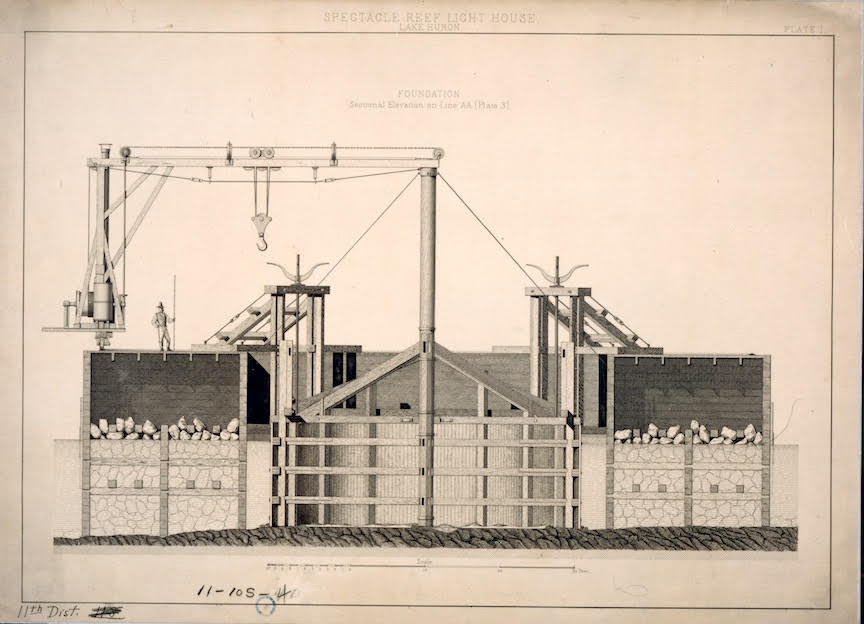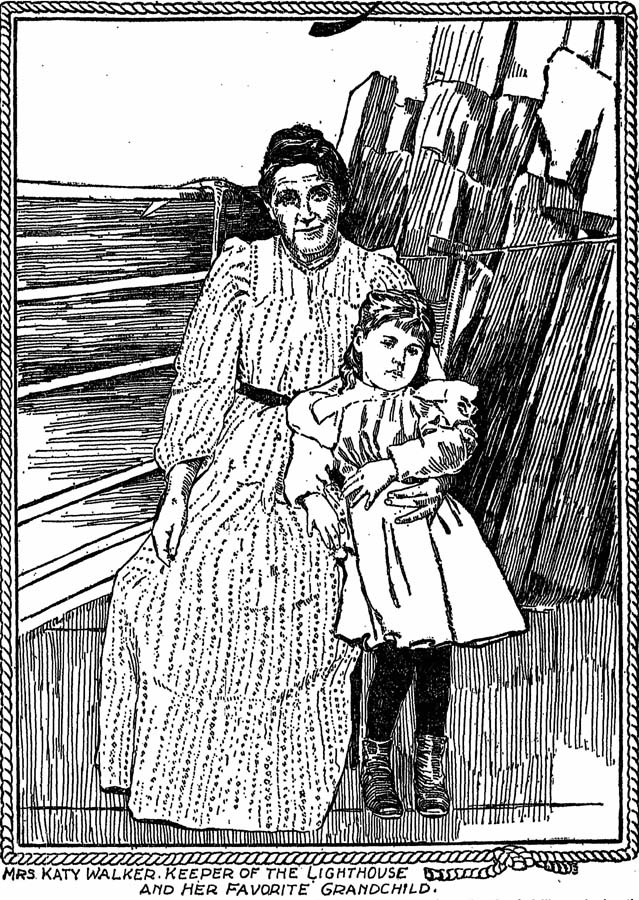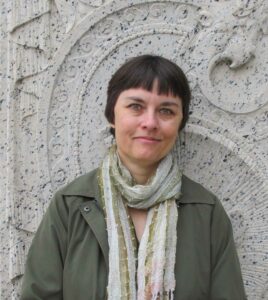Kate Walker here, keeping the light on Robbins Reef.. I know that at least two people are reading my blog because they caught the typo in the last post.

Two more architectural types that I haven’t discussed were used offshore. My lighthouse on Robbins Reef is on a crib. According to Lighthouse Friends, “A wooden cofferdam was pieced together on the reef, made watertight, and pumped dry. Workmen then entered the cofferdam and built up a foundation that was subsequently capped with a granite, circular crib. Atop this crib, a four-story, iron sparkplug tower was erected.” Wooden cribs, constructed onshore, towed to the site, and then filled with stone to sink them in place were a lighthouse foundation type used in places where a hard rock bottom would not allow for a caisson or screwpile.

Construction of Toledo Harbor Lighthouse began in 1901. Since there was no outcropping of rock to use as a foundation, the Army Corps of Engineers came up with a creative way to build the light in the middle of the lake. They sunk a large crib below the water and filled it with stone. Once the crib was in place, they topped it with a concrete base, completing the artificial island. The engineers next put steel frames in place, providing stability for a three-story brick structure. Attached to it was a one-story fog signal building. Both structures are still standing today. A light tower projects from the roof of the dwelling.


Caisson foundations worked well in unconsolidated bottoms composed of sand or mud. The caisson lighthouse used a large cast-iron cylinder, which was sunk on the bottom and filled with rock and concrete to form a foundation. The caisson foundation was sturdier and better able to withstand heavy stress than the pile foundation lighthouses, so it is not surprising that caisson lighthouses were built in areas where moving ice was a hazard. Brandywine Shoal in New Jersey replaced a pile lighthouse in 1914. Where bottoms were harder, contained rocks, and/or needed greater depth of penetration into the substrate, a pneumatic process was used. The substrate within the caisson was removed and the caisson allowed to sink further into the bottom. Eleven pneumatic caisson lighthouses were built in the United States. The Sabine Bank Lighthouse (1905) in Texas is the most exposed, located 15 miles offshore in the Gulf of Mexico, the only caisson south of the Chesapeake Bay.
A relatively recent technological development in lighthouse construction was the Texas tower type which replaced exposed lightships offshore. Texas towers were modeled on the offshore oil drilling platforms first employed off the Texas coast. The first Texas tower lighthouse in the United States was the Buzzards Bay Light, located in Buzzards Bay, Massachusetts, and commissioned on November 1, 1961. A total of six Texas tower lighthouses were constructed.
I’m very curious about caissons and Texas towers because I’ve never seen any of them. I’m delighted, however, to offer you photos and drawings of cribs and caissons.
 Sources: Lighthouse Friends and Historic Lighthouse Preservation Handbook, Part 4
Sources: Lighthouse Friends and Historic Lighthouse Preservation Handbook, Part 4
Submitted February 7, 2018
* * * * *
U.S. Lighthouse Society News is produced by the U.S. Lighthouse Society to support lighthouse preservation, history, education and research. Please join the U.S. Lighthouse Society if you are not already a member. If you have items of interest to the lighthouse community and its supporters, please email them to candace@uslhs.org.

Candace was the US Lighthouse Society historian from 2016 until she passed away in August 2018. For 30 years, her work involved lighthouse history. She worked with the National Park Service and the Council of American Maritime Museums. She was a noted author and was considered the most knowledgable person on lighthouse information at the National Archives. Books by Candace Clifford include: Women who Kept the Lights: a History of Thirty-eight Female Lighthouse Keepers , Mind the Light Katie, and Maine Lighthouses, Documentation of their Past.


Hi Kate,
Make that 3 readers, still enjoying your posts from Australia 🙂
Very interesting stuff!
Cheers,
Jesse.
Keeper Kate, I imagine you have lots of readers. I read everyone you send. I can send you a picture of Chesapeake Texas Tower if you like. It may take a day or two to find it.